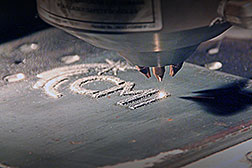- Number 413 |
- May 12, 2014
Speeding up critical metals research with 3D printer

Critical Materials Institute speed metals
research with 3D printer.
To meet one of the biggest energy challenges of the 21st century—finding alternatives to rare-earth elements and other critical materials—scientists will need new and advanced tools.
The Critical Materials Institute at the U.S. Department of Energy’s Ames Laboratory has a new one: a 3D printer for metals research.
3D printing technology, which has captured the imagination of both industry and consumers, enables ideas to move quickly from the initial design phase to final form using materials including polymers, ceramics, paper and even food.
But the Critical Materials Institute (CMI) will apply the advantages of the 3D printing process in a unique way: for materials discovery. By doing so, researchers can find substitutes to critical materials-- ones essential for clean energy technologies but at risk of being in short supply.
CMI scientists will use the printer instead of traditional casting methods to streamline the process of bulk combinatorial materials research, producing a large variety of alloys in a short amount of time.
“Metal 3D printers are slowly becoming more commonplace,” said Ryan Ott, principal investigator at the Ames Laboratory and the CMI. “They can be costly, and are often limited to small-scale additive manufacturing in industry. But for us, this equipment has the potential to become a very powerful research tool. We can rapidly synthesize large libraries of materials. It opens up a lot of new possibilities.”
The CMI printer, a LENS MR-7 manufactured by Optomec of Albuquerque, N.M., uses models from computer-aided design software to build layers of metal alloy on a substrate via metal powders that are melted by a laser. Four chambers supply metal powders to the deposition head that can be programmed to produce a nearly infinite variety of alloy compositions. The printing occurs in an ultra-low oxygen glove box to protect the quality of highly reactive materials. In a recent demonstration run, the printer produced a one-inch long, 0.25-inch diameter rod of stainless steel in 20 seconds.
The process will overcome some of the obstacles of traditional combinatorial materials research.
“The problem is that it’s been typically limited to thin film synthesis. These thin film samples are not always representative of the bulk properties of a material. For example magnetic properties, important to the study of rare earths, are not going to be the same as you get in the bulk material,” explained Ott.
Combined with computational work, experimental techniques, and a partnership with the Stanford Synchrotron Light Source (SSRL) for X-ray characterization, scientists at the CMI will be able to speed the search for alternatives to rare-earth and other critical metals.
“Now we have the potential to screen through a lot of material libraries very quickly, looking for the properties that best suit particular needs,” said Ott.
This research is supported by the Critical Materials Institute, a Department of Energy Innovation Hub led by the U.S. Department of Energy’s Ames Laboratory. CMI seeks ways to eliminate and reduce reliance on rare-earth metals and other materials critical to the success of clean energy technologies. DOE’s Energy Innovation Hubs are integrated research centers that bring together scientists and engineers from many different institutions and technical backgrounds to accelerate scientific discovery in areas vital to U.S. energy security.
Ames Laboratory is a U.S. Department of Energy Office of Science national laboratory operated by Iowa State University. Ames Laboratory creates innovative materials, technologies and energy solutions. We use our expertise, unique capabilities and interdisciplinary collaborations to solve global problems.
Submitted by DOE’s Ames Laboratory
